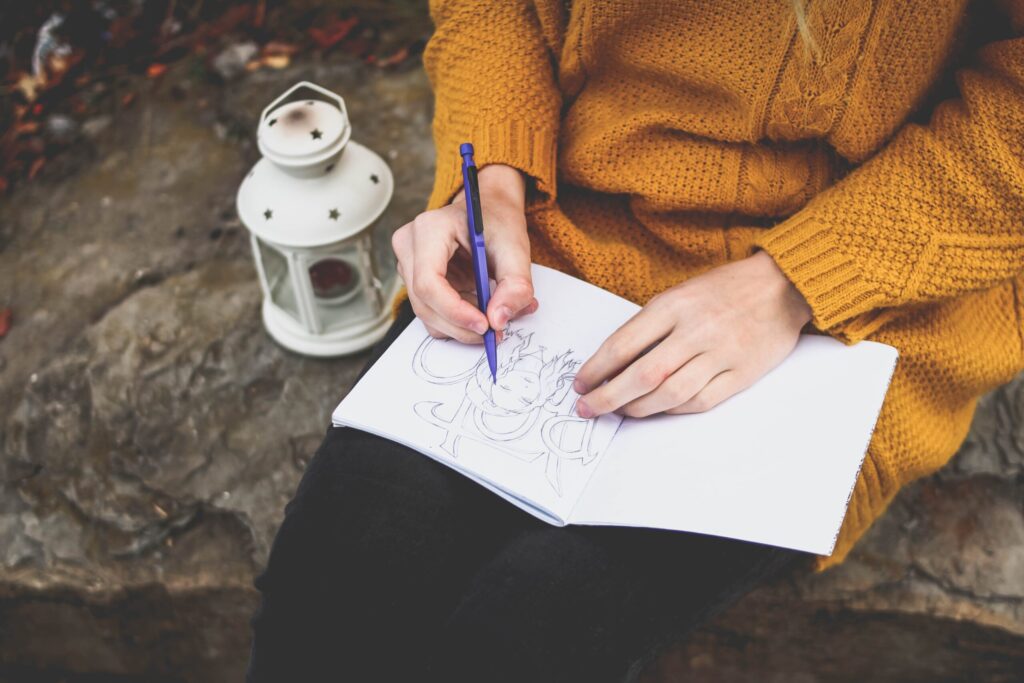Many years ago a client named Susan came in seeking help at the urging of her mother. She was 17 years old. She was a survivor of a major house fire when she was 15 years old. No one was badly hurt, but the entire home had gone up in flames. In the year’s following, Susan had been experiencing trauma symptoms. She was unable to sleep through the night. She was restless, easily distracted and became overly cautious about anything related to her safety or the safety of her loved ones.
Sessions with Susan were initially challenging. Susan did not speak much about her experiences or her symptoms. She gave one-word refrains or two-sentence replies at best and almost exclusively chatted about school. These quiet sessions turned into a source of tension for Susan because her mother was unwilling to let her stop going.
Sessions remained like this for about three weeks until a lightbulb moment happened: Art therapy.
Susan had never specifically mentioned being an artist, but she had said that art class was her favorite since it gave her a chance to be creative. Prior to the fire, she enjoyed museums, reading, photography, and baking.
What is Art Therapy?
Art therapy is a mental health tool that utilizes an art-making, creative process along with applied psychological theory in a client-centered experience to support and facilitate a psychotherapeutic relationship.
A professional art therapist facilitates art therapy. While not without the use of conversational interventions, it focuses on personal, relational and community-oriented treatment goals through the lens of a creative process such as painting, poetry, writing and more.
Art therapy, facilitated by a professional art therapist, effectively supports personal and relational treatment goals, as well as community concerns. It is used to improve cognitive and sensorimotor functions, foster self-esteem and self-awareness, cultivate emotional resilience, promote insight, enhance social skills, reduce and resolve conflicts and distress, and advance societal and ecological change (American Art Therapy Association, 2018).
Art Therapy for Anxiety
Susan was working through a great deal of anxiety after surviving the fire. Talking about it was impossible for her at that time. She was too activated and too triggered to engage in any kind of processing. She was still in survival mode.
After the lightbulb moment, Susan received watercolor paints, a canvas, and brushes. Instead of talking, she sat and painted very slowly. She watched the water mix with the blues, greens and yellows drip from her brush onto the canvas.
After three weeks of creative sessions, she started to talk as she painted. Susan mentioned that this felt relaxing to her. She liked watching the colors mix with the water and then to see the lighter and darker shades dry. She said that she wasn’t painting anything in particular, just abstract shapes and colors because she felt that this helped her feel less pressure about painting something “good.”
What Was Happening for Susan?
There is increasing evidence in rehabilitation medicine and the field of neuroscience that art enhances brain function by impacting brain wave patterns, emotions, and the nervous system. Art can also raise serotonin levels. These benefits don’t just come from making art, they also occur by experiencing art. Art therapy encourages creativity and self-expression; experiences that are often inaccessible in conventional therapy spaces. Self-exploration can be a hindrance when trying to communicate via normal language and expression, but with art therapy you are giving yourself the artistic license to really explore and not only find, but define new things about yourself (American Congress of Rehabilitation Medicine, 2022).
After the Art Therapy
With Susan, after months of building a relationship through presence, art, and talking, she was able to open up. Susan had not been able to let go of the experience of waking up and running out of the house barefoot, in her pajamas. She could not let go of the idea that her parents and little brother may have died that day. She could not find the words or tears to express that and keeping it inside felt like the safest thing. By expressing herself through abstract art, she felt like she could transfer some of the images that she was holding in her head onto the canvas, even if it did not look like a house or anything related.
Art therapy was not the final step for Susan. She still felt deep guilt because she thought she had caused the fire. Her and her family had come back in for family sessions using more specific approaches like ACT and CBT to help process some of the stories they held around their experience. Additionally, Susan and her family also worked on their needs using ERP to help release the hold some of this trauma had on them.
Through an individualized approach for the family, they were able to find the language to express their grief and come back together after a terrible tragedy. While their life ahead may not be one that is ever fully free from their memories, it may be one of working together with honesty and awareness about their next steps.






